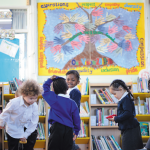
September 4, 2017, by Rupert Knight
What do we mean by school-ready?
This September, most 4 year old children in the UK will start school for the first-time. Due to the offer of free childcare places for all 3 to 4 year olds, most of these will have experienced being in some sort educational environment although these will differ greatly. In addition, their home experiences will be diverse. In this post Helen Victoria Smith considers school-readiness and the need for clarity about this concept.
Imagine two children about to start school. They are both five years old and are eagerly anticipating their first day. Imagine that each brings with them to school a virtual schoolbag full of things they have learned at home, with their friends, and in and from the world in which they live (Thomson, 2002, p.2)
As Pat Thomson illustrates above, children arrive at school with different virtual schoolbags which shape their experience of it. An example of this can be seen in Shirley Brice Heath’s (1983) famous study of the desegregation of two culturally different communities in the USA, which revealed how children learned to use language in very different ways, and how this affected the ways they experienced school. As a result, teachers and academics began to question how they could best meet the needs of these children. In other words, they wanted to know how schools could be made ready for children.
But there has been a shift.
Started in 1997 and concluded in 2014, the Evaluation of Preschool, Primary and Secondary Education (EPPSE) project found that a child’s home learning environment significantly influenced their development. In the early years, activities such as reading regularly to a child, taking them to the library, teaching numbers and nursery rhymes, painting, drawing and singing were found to be more important for children’s intellectual and social development than parental occupation, education or income. In other words if parents could be encouraged to do the ‘right’ things with their child before they started school, then they would be more likely to succeed. Furthermore, they found that children who attended a high-quality preschool, especially if they were from a disadvantaged background, would be more able to keep up with their better-off peers when they started school. These findings have strongly influenced different UK governments over the past 20 years, who have emphasised the importance of the early years for children’s academic and future economic success. This has led to the expansion of free childcare places, early intervention (e.g. Sure Start) and an increased focus on parental involvement in children’s education. As a result, it seems that the question now being asked is:
How can children be made ready for school?

This has huge implications, not least for the children, but also for those working with them. In an educational climate where schools and their teachers are judged according to the educational attainment and progress of their children, children who are not seen to be ready to school at the age of 4 become a ‘problem’ needing to be fixed. And as a result, parents and early-years professionals come under increasing pressure to make sure children in their care are on course to reach a ‘good level of development’ by the time they finish their first year of schooling. If they fail to do so, they are at risk of being blamed and vilified, as can be seen in news reports with headlines such as ‘Nurseries not preparing children for school’, ‘Boys trail girls in literacy and numeracy when starting school’ and ‘A third of children not ‘school-ready’ for Reception’.
However, what is also evident in these reports is that there isn’t an agreed definition of what children actually need to be able to do to be school-ready. While some focus on social and personal skills, others focus on literacy and numeracy skills.
In England, the Statutory Framework for the Early Years Foundation Stage (DfE, 2017) sets out seven areas of learning for children aged 0 to 5 that early years’ providers must follow and assess children against. This document defines a ‘good level of development’ (GLD) at the end of this stage as achieving (at least) the expected level in the five areas of communication and language; physical development; personal, social and emotional development; literacy and maths. If children have a ‘good level of development’ then they are considered to have the skills needed to access the Key Stage 1 (ages 5-7) primary curriculum (DfE, 2013). However, starting school in England means entering a Reception class (in the school year in which the child turns 5) not the start of Key Stage 1. So this definition is not particularly helpful in establishing an understanding of ‘school-ready’ for the vast majority of children who enter school at the age of 4.
Schools and early-years providers are therefore having to turn to other organisations to help them define ‘school-readiness’. PACEY (Professional Association for Childcare and Early Years) have produced materials for parents and professionals to help them understand what a child needs to do to be school-ready. In 2013, they also produced a report into what parents, professionals and children felt being school-ready meant. Not surprisingly, they found that many different definitions exist, but that the people in their study focused on social skills, independence and a curiosity to learn, rather than more academic skills and knowledge. Meanwhile, the Department for Education includes ‘beginning to read and write and use numbers’ in their definition,
In their first few years children learn to walk and run, to speak and communicate, to relate to others, to play, explore their own curiosity, and to enjoy learning through their play, as well as beginning to read and write and use numbers. They are the key elements of ‘school readiness’. (DfE, 2011, p.18)
So what now?
As long as what it means to be school-ready remains fuzzy and contested, teachers, parents and early years’ professionals are likely to be unsure about how best to support young children. For children who are already disadvantaged, this could mean struggling to adapt to the demands of the school curriculum and falling behind their peers. It is important that as practitioners and parents, we take time to consider what we mean by being school-ready. Maybe the questions we should be asking are:
- What do we want our children to be able to do when they start school?
- How can we support them, their parents and early years’ professionals so they have a strong start to their school life?
References
DfE (2011) Supporting Families in the Foundation Years. London: Department for Education.
DfE (2013) The National Curriculum in England: Key Stages 1 and 2 framework document. London: Department for Education
DfE (2017) Statutory Framework for the Early Years Foundation Stage: Setting the standards for learning, development and care for children from birth to five. London: Department for Education
EPPE/EPPSE reports can be found at:
https://www.gov.uk/government/collections/eppse-3-to-14-years
Heath, S. B. (1983) Ways With Words: Language, life, and work in communities and classrooms. Cambridge: Cambridge University Press
Thomson, P. (2002) Schooling the Rustbelt Kids: Making the difference in changing times. Stoke on Trent: Trentham Books

The more we look at this, the more complex it becomes. In addition to the many very apt points Helen makes here is the other conundrum, that at the start of Reception some children are just 4 while others are turning 5. When you also bring in the mysterious fact that another of the 7 areas of learning, Understanding of the World (rather large topic) is not even included in the Good Level measure, this becomes still more perplexing. And at the same time the government is planning to trial the Early Years PISA test – this is likely to become the new readiness measure and will herald more formalisation / schoolification. Rather a depressing picture to start the year unless practitioners and researchers in EY stand up very strongly.
I just do not feel the current, accountability-led “schoolification” of EY is right. And I don’t think the very data cited to support it tells a different tale. Wellbeing and socialisation are harder to measure than phonemes but just as vital.
nice blog